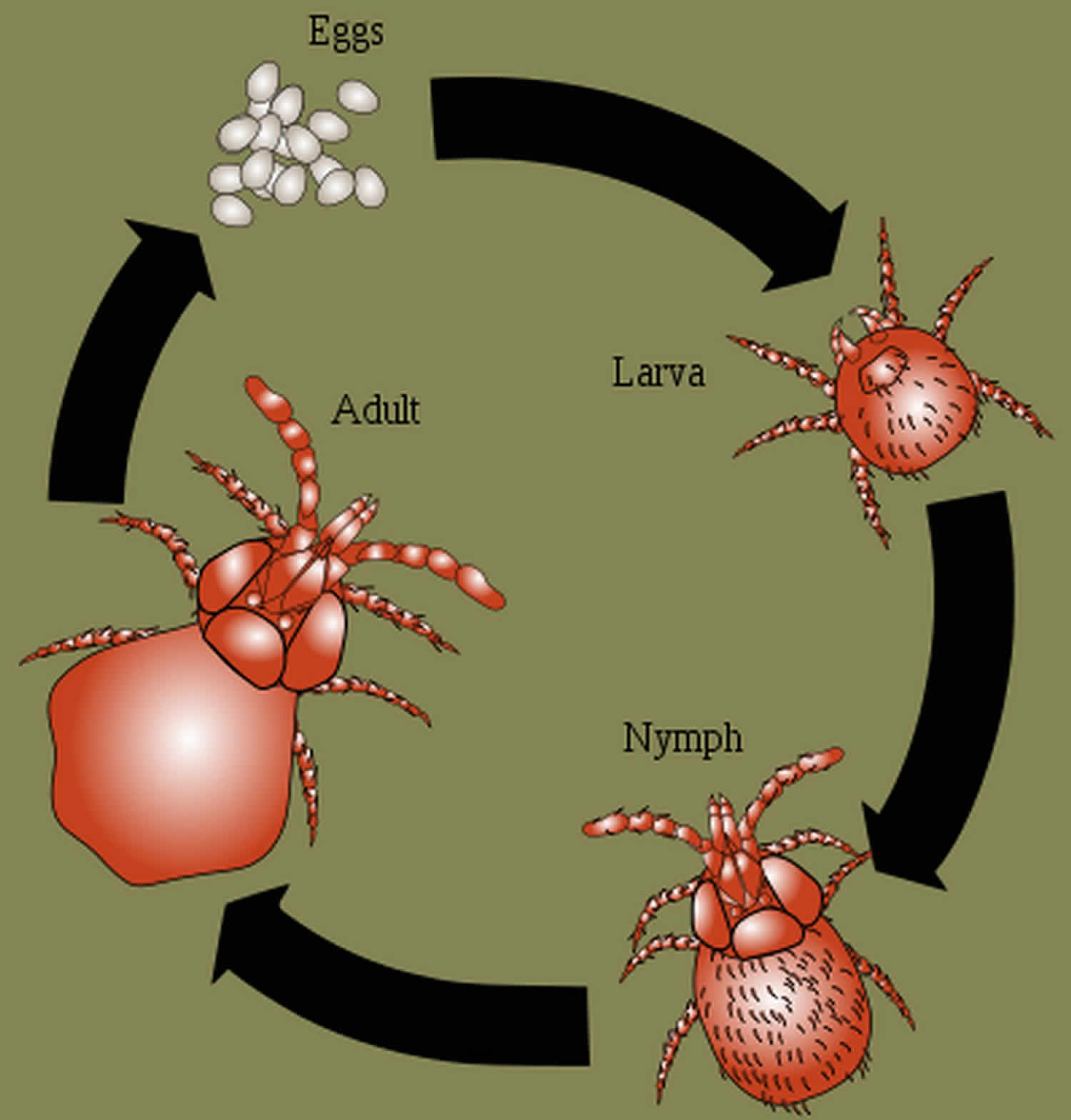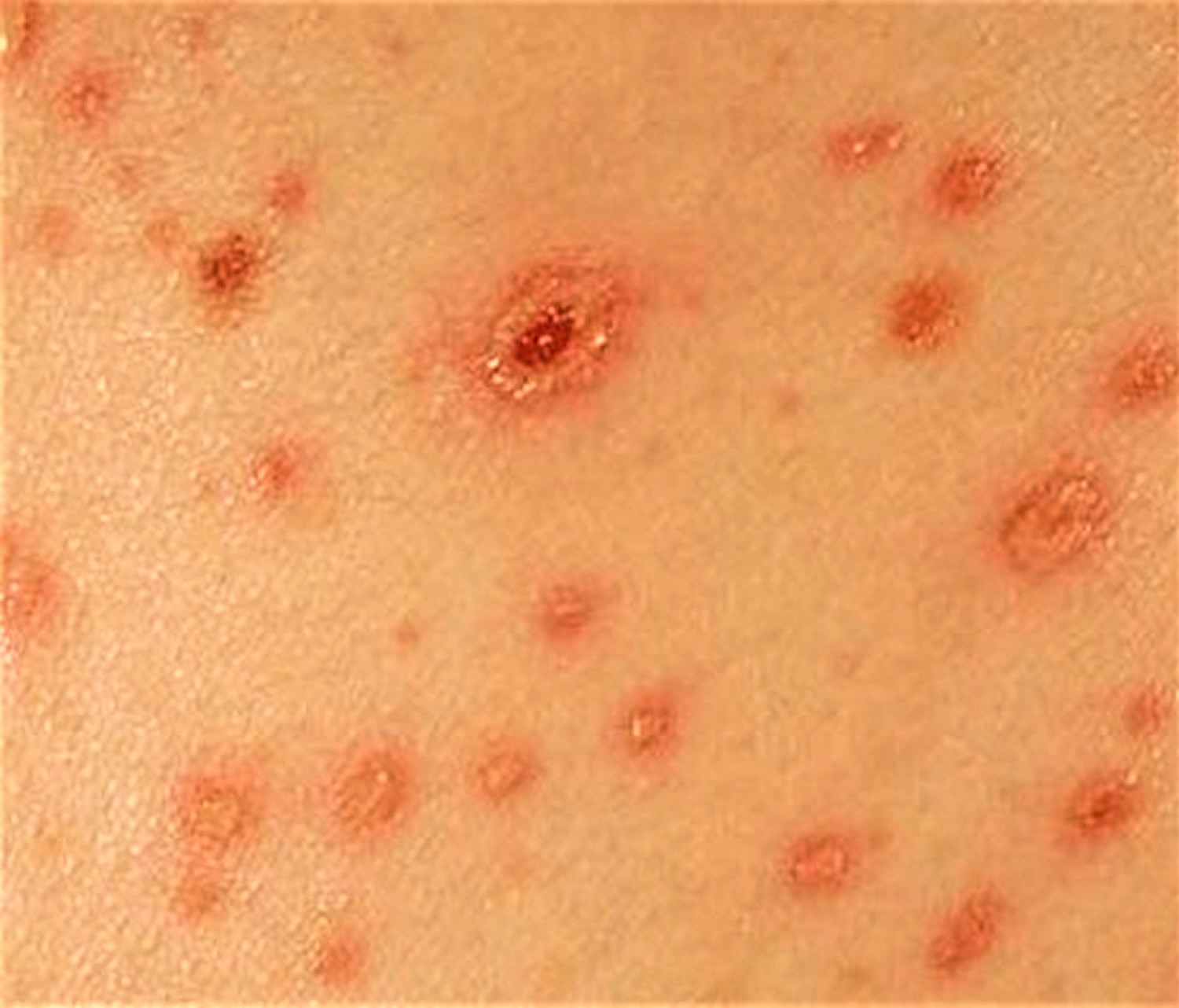Contents
What are chigger bites
Chiggers are tiny arachnids (family Trombiculidae, subclass Acari) having four pairs of legs, most can only be seen with a magnifying glass and they’re hairy 1. Chigger mites color varies from yellow-orange to a light red. Mites aren’t insects — they are arachnids and part of the same family as spiders, scorpions, and ticks. In North America the common chigger that attacks humans is Eutrombicula alfreddugèsi (also called Trombicula irritans). This species occurs from the Atlantic coast to the Midwest and southward to Mexico. The tiny larvae easily penetrate clothing. Once on the skin surface, they attach themselves and inject a fluid that digests tissue and causes severe itching. The surrounding tissue hardens, forming a tube.
Chiggers are found in certain outdoor areas, such as:
- Berry patches
- Tall grass and weeds
- Edges of woodlands
It is only the “baby” chigger mites (called larvae) that bite people. Apparently, once they mature to adulthood, they grow out of their immature and obnoxious behavior of biting people, and live the rest of their lives feeding peacefully on plants.
Chiggers bite humans around the waist, ankles, or in warm skin folds. Bites commonly occur in the summer and fall months. Humans are exposed to chiggers every summer from May through September throughout the country.
Chiggers are found in tall grassy areas such as near wooded areas, grassy fields, along lakes and streams, and in forests and in lawns, where they live near the soil surface. Heat and high humidity increase chigger populations. Keeping areas mowed helps reduce numbers but is a not guarantee of preventing bites. Chiggers can be concentrated in one area and not in an adjacent one. As the need for nourishment increases, the chigger moves higher and higher on the vegetation and waits for the host. There are adult chiggers and baby chiggers (called larvae), but only the baby (larvae) chiggers bite people and animals (see Figure 2 below). Chigger larvae are so small (approximately 0.2–0.3 mm long) that they are seldom seen 1.
Gangs of juvenile chiggers all have the following modus operandi. They hang out on the tips of tall grasses, shrubs and weeds and wait to drop off onto any larger animal that happens to brush by. Usually these animals are birds, amphibians or small mammals but the mites are just as happy with the odd human that passes by. When chigger mites fall onto shoes or pant legs, they begin climbing in search of tender, moist skin to bite. Chiggers seem to concentrate in areas where clothing fits tightly against the body, such as around the ankles, groin, waist or armpits.
Chiggers have tiny claws that allow them to attach tightly onto people and animals. Once attached, they can pierce the skin and inject their saliva (spit), which contains digestive juices that dissolve skin cells. The chigger then slurps up the dissolved skin cells. To the chigger, this is a tasty meal! Having a chigger do this is very irritating to your skin.
After a few days, the larva chigger will be done feeding and fall off a person’s skin, leaving behind a red welt where it had once been.
After feeding, the larva drops to the ground and sheds its external skeleton to become a nymph and finally an adult. Nymphs and adults are not parasitic on vertebrates but feed on plant materials and perhaps other arthropods. Eggs are laid singly on the ground or on leaves or stems of low-growing plants (see Figure 2 below).
Chigger infestations are caused by mite larvae that feed on the host’s epidermal cells. The combination of digestive enzymes secreted by the chigger mite and the immune response of the host produces the typical “chigger bite.” Intense itch is the usual response, but more severe reactions and chigger-borne disease may also occur. Treatment is primarily symptomatic and consists of antipruritics, antihistamines and steroids. Chigger infestation may be minimized by the use of proper clothing and insect repellents.
Figure 1. Chigger mite
Figure 2. Chigger mites life cycle – the life cycle for most chiggers includes a six-legged parasitic larva stage
How long do chigger bites last?
The itchy bump can last for days or even a couple of weeks.
How will I know that I’ve been bitten by chigger mite?
A reliable method is to feel and see the reaction chigger mite puncture wound has on your skin. The site of the chigger bite will begin to itch within three to six hours and the temptation to scratch increases dramatically. The worst itching will last a couple of days then gradually subside. The red mark often with a raised pustule center slowly goes away over the next week if the skin isn’t broken or infected.
What do chigger bites look like?
The chigger mite creates a puncture wound but doesn’t burrow under the skin, as some people suggest. It can take about an hour for the chigger mite to reach a feeding spot (thin and moist skin) and begin feeding. Unlike ticks and mosquitos, which can penetrate many types of skin, chiggers have relatively weak mouth muscles and cannot physically penetrate skin that you normally have exposed to the outside world, such as your arms, legs, and face. They are forced to target areas that are usually protected by fabrics or other body parts. The chigger penetrates the skin with its mouthpieces. It then injects an enzyme into the wound that breaks down the skin cells that it then extracts. The red mark often with a raised pustule center slowly goes away over the next week if the skin hasn’t become infected.
If a person gets bitten by a chigger, the bite will be very itchy. The itching and redness caused by the chigger bite is a histamine (allergic) response. A chigger bite will cause a tiny red bump, which will get bigger and itchier as time goes on. The itchy bump can last for days or even a couple of weeks.
Figure 3. Chigger bites
Chigger bites symptoms
The main symptoms of chigger bites are:
- Severe itching
- Red pimple-like bumps or hives
Itching usually occurs several hours after the chiggers attach to the skin. Chigger bite itself is painless.
A skin rash may appear on the parts of the body that were exposed to the sun. It may stop where the underwear meets the legs. This is often a clue that the rash is due to chigger bites.
How can chigger bites be prevented?
These methods are for the prevention of chigger bites.
Avoid getting into chiggers in the first place. Stay away from tall grasses and shrubs where chiggers are known to live. Chiggers love to live in brambles, as most people who pick black raspberries know or quickly learn. They also inhabit taller grasses close to the ponds and streams where bank fishermen stand. (Both raspberry pickers and fishermen can easily be spotted due to their obsessive scratching).
You should also wear appropriate clothing whenever you go outdoors. If you use high shoes or boots, wear thick socks, long sleeve shirts and long pants, you will reduce the chances of getting chigger bites. It is advisable that you stuff the pants into the tops of the boots. You should also put some mosquito repellent containing DEET on your shoe, ankle area and clothes when you are going outdoors. This will stop many of the mites from gaining access to the skin and beginning their climb to areas where clothing fits tightly.
If you know or suspect that you have been in chigger-infested habitats, take a hot, soapy shower as soon as possible. The mites are so small that it may take them several hours to crawl from shoes to where they want to bite, so you have plenty of time to wash them away. This is an effective prevention. Change your clothes that you were wearing outdoors and put the clothes you were wearing into the washer and dryer, so as to kill any chiggers remaining there.
Chiggers will not bite when temperatures are low; therefore temperatures should be observed whenever you go outdoors. They are also not found in very hot areas, so you can comfortably sit on a rock in hit rocky areas without worrying about chiggers.
How to treat chigger bites
The goal of chigger bites treatment is to stop the itching. If you think you’ve been bitten by a chigger, wash the bite with soap and water. To help with the itching, put some calamine lotion and corticosteroid ointment to the site or a cold compress (like ice wrapped in a clean towel) on the area, since they alleviate the itchiness and inflammation. You can also find an anti-itch cream or medicine at the drugstore for you. Try not to scratch the bites too much because this can make them become infected.
You may also take oral antihistamines if you feel that the itching has become too much.
Hydrogen peroxide also helps in alleviating the effects of a chigger bite. Take a cotton ball and soak it in hydrogen peroxide, then hold it on the affected area for a few minutes. You should also move it around gently so that you get the entire area. You should repeat this a few times until the itchiness subsides.
What to put on chigger bites
Because chigger bites are so itchy, many people do get an infection from scratching them so much. If this happens, the doctor will prescribe a medicine to help with the itching and a medicine to clear up the infection.
Your doctor can sometimes prescribe an antiseptic/hydrocortisone ointment. This may help ease the itch and reduce chances of secondary infections caused by the itching and scratching, but it is not a perfect answer.
- Kumlert R, Chaisiri K, Anantatat T, et al. Autofluorescence microscopy for paired-matched morphological and molecular identification of individual chigger mites (Acari: Trombiculidae), the vectors of scrub typhus. PLoS One. 2018;13(3):e0193163. Published 2018 Mar 1. doi:10.1371/journal.pone.0193163 https://www.ncbi.nlm.nih.gov/pmc/articles/PMC5832206/[↩][↩]








